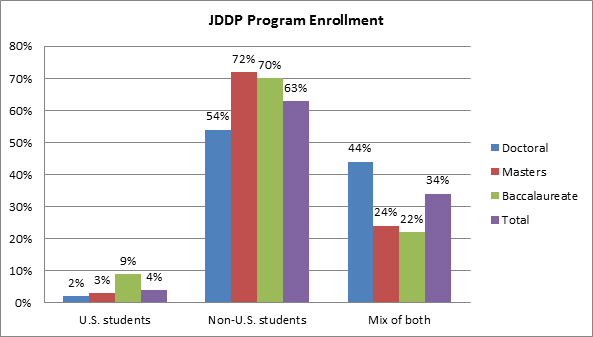By Robin M. Helms
International joint and dual degree programs (JDDPs) have been a hot topic at ACE’s Center for Internationalization and Global Engagement (CIGE) in recent months.
Through our work with institutions in the Internationalization Laboratory and our other programs, we know that many colleges and universities are pursuing such programs with partners abroad as part of their internationalization strategies. Data from our Mapping Internationalization on U.S. Campuses study and various other sources indicate that JDDPs are indeed gaining steam worldwide.
CIGE’s 2014 report, Mapping International Joint and Dual Degrees: U.S. Program Profiles and Perspectives explores the landscape of such programs in the United States, including program characteristics and policies, academic focus areas, partner locations and programmatic challenges, as well as their role in broader institutional strategy and planning. Our study used survey data to identify key issues and national trends, but then complemented the numbers with insights from campus practitioners on practical applications and good practices.
Perhaps the most striking finding of the study was that a majority (over 60 percent) of the JDDP’s included in the survey enroll only students from outside the United States. We often hear that institutions are pursuing JDDPs in order to deepen their relationships with partners abroad, yet the data raise concerns that these programs may be more about transferring credits and recruiting international students than building substantive connections with partners abroad.

When asked about this enrollment skew in follow-up interviews, respondents for the most part were not surprised. They cited language ability as a considerable barrier to U.S. students earning a degree abroad—even the most diligent Chinese language student in the United States, for example, is unlikely to reach a level of proficiency by her junior year that will allow her to complete full a degree at a Chinese institution.
Some questioned the value of the dual degree for U.S. students: If they don’t intend to pursue a career in international relations, what is to be gained from holding a foreign credential in addition to their U.S. degree? Won’t a short-term study abroad achieve the same results in terms of “value added” on their resume?
The news is not all bad, however. There are good examples of programs that enroll both U.S. and non-U.S. students, a number of which are included in the report.
In some cases, respondents also noted that their joint and dual degree programs (that enroll only non-U.S. students) are part of broader relationships with their partner institutions abroad. While U.S. students don’t earn a second credential, they may participate in short-term study abroad programs at the partner institution. Faculty exchanges, research collaborations and other activities may complement the JDDP.
As institutions consider whether or not to pursue joint and dual degree programs, it’s important to keep in mind the goals of such programs, and how they contribute to meaningful relationships with partners abroad, as well as to broader internationalization efforts on campus. Mutuality and reciprocity—the spirit of “joint” and “dual”—are possible, but may take some creative thinking and purposeful planning.
CIGE is not done with joint and dual degrees. JDDPs are also the focus of the upcoming installment of International Briefs for Higher Education Leaders, our collaboration with the Boston College Center for International Higher Education. As part of the Briefs project, we’re offering a webinar on JDDPs on April 16. Further information is available here—we hope you can join us.
If you have any questions or comments about this blog post, please contact us.

